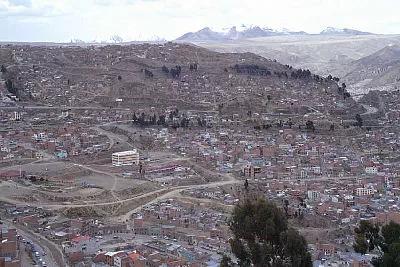La Paz, Bolivia Overview
Getting There and Getting Around
- By air to El Alto Airport, which is located just 25 minutes from the center of La Paz. You can take a taxi or minibus into town, or arrange for your hotel to send a taxi for you. The airport is situated on the altiplano above the city, and planes approach rapidly due to the 4100 m elevation.
- By bus to the main bus terminal on Plaza Antofagasta at Avenida Uruguay.
- By taxi around town, although navigating the steep streets is easier if you can walk. The center of La Paz is very walkable, and locals, known as paceños, are accustomed to the altitude and tend to walk quickly.
- Trains in Bolivia are generally slow but inexpensive.
When to Go
- The best time to visit is from April to October. La Paz has a moderate temperature year-round, averaging between 35-65°F. Regardless of when you visit, be prepared for windy and cold nights, as many buildings are not heated after dark. Summer also brings in the wet season.
- Altitude sickness can be a concern, so it is important to acclimatize properly. You should also check current weather conditions.
Things to Do and See
- Visit Plaza Murillo, once known as Plaza de Armas, named after one of the heroes of Bolivia’s independence movement. This central plaza is surrounded by important buildings like the cathedral and the Government Palace.
- Explore the historic Iglesia de San Francisco, reconstructed in 1784, showcasing a blend of Christian and indigenous artistry.
- Discover ancient artifacts at the Museo de Oro, which houses objects from the pre-Columbian era.
- Walk along Jaen Street, a charming cobblestone street that reflects colonial history.
- Check out the Casa Murillo Museum for a glimpse into colonial art and furnishings.
- Visit the Museo Nacional de Arqueología for insights on Tiwanaku, Bolivia’s main archaeological site.
- Don’t miss the Feria de Alasita, which takes place on January 24, showcasing miniature figurines.
- Take part in Carnaval celebrations, notably the Devil’s Dance (diablada) in Oruro.
- Attend a local peña for an evening of folk music and dancing, often accompanied by traditional meals.
- Enjoy stunning views from Mirador Laikakota, which is also a children’s park.
- Consider sidetrips to surrounding attractions like Lake Titicaca and Valle de la Luna (Moon Valley).
Food and Drink
La Paz’s culinary scene features both traditional Bolivian dishes and international cuisine. Be sure to try local specialties, such as salteñas, which are empanada-like pasties that originated in Argentina. The daily specials offer an affordable meal option, typically consisting of soup, entree, and dessert, sometimes accompanied by salad and coffee.
Lunch (almuerzo) is considered the main meal, while dinner is lighter, often featuring popular appetizers like anticuchos, which are skewered beef hearts. In addition to coffee and tea, locals enjoy various beverages, including Paceña Beer and traditional drinks like chicha. For breakfast, a sweet corn-based drink called api is commonly enjoyed.
Also, don’t forget to try the local chuflay cocktail, which combines 7Up, lemon, and singani, a distilled grape liquor. Enjoy your visit to La Paz and immerse yourself in its rich culture!





